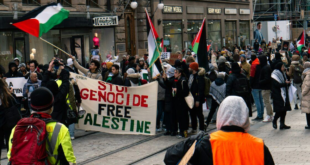BAGHDAD (AFP) — Two final witnesses told Saddam Hussein’s genocide trial Thursday of the horrors of the anti-Kurdish Anfal campaign, before the court adjourned for a week in preparation of its next phase.
Two doctors living in northern Iraq’s Kurdish region described treating a steady stream of victims of government gas attacks.
Court officials said they would be the final eyewitnesses as the court looks set to resume on December 18 and receive documentary evidence allegedly linking the defendants to the anti-Kurdish campaign.
The brief session was delayed due to a security alert in the capital’s heavily fortified Green Zone, where the court is located.
Defence lawyers — those not boycotting the proceedings — spent two hours trying to enter the Green Zone after sniffer dogs near detected a suspect smell in a different group of visitors and the area was sealed off.
The area was “locked down for a potential device, one of the dogs sat down” signalling it had possibly sniffed explosives, said US spokesman Lieutenant Colonel Christopher Garver.
The trial eventually began with all seven defendants in court, including Saddam who on Tuesday had written a note to the judge to be excused from the trial, as well as a number of the defence lawyers.
The witness testimony began immediately with a doctor working with the Kurdish guerrilla forces at the time describing what he called the first poison gas attack by Iraqi forces under the Saddam regime.
At first, “it was not a bad smell … it smelt like flowers,” the doctor told the court. “After some time I went back to my village and saw dozens of women and children walking with their eyes red, many were vomiting blood.” The doctor decribed how for months afterwards victims of gas attacks would appear at his hospital and in one case, even himself caught a whiff of the toxic brew.
“I felt a burning sensation on my skin and blood used to come up whenever I coughed,” said the witness, whose name was not provided, but who appeared undisguised before court.
The final witness of the day, also a doctor whose name was not provided, told his own stories of Kurdish patients, including one in particular who was horrifically burned by a chemical attack.
“In the few days that we treated him, his entire body was full of chemical bubbles and then he died,” he said.
Saddam and his six co-defendants are accused of killing 182,000 Kurds in the late 1980s when government troops suppressed a Kurdish uprising with artillery, air strikes and poison gas attacks.
Saddam and his cousin Ali Hassan Majid are the only two defendants specifically charged with genocide.
Thursday’s witnesses should mark the end of witness portion of the trial, which has seen more than 70 people, mostly Kurds affected by the attacks, describe the campaign.
Last week, expert witnesses presented technical details of how Saddam’s forces attacked the Kurds during the Anfal campaign.
Citing forensic evidence, American expert Michael Trimble described the killings and mass graves as a “highly organised programme of execution”.
According to the former regime, the Anfal campaign was a legitimate counterinsurgency operation against Kurdish separatists at a time when Iraq was at war with neighbouring Iran.
 Eurasia Press & News
Eurasia Press & News

